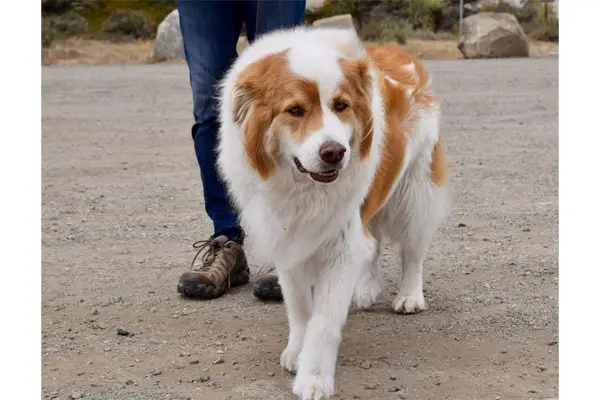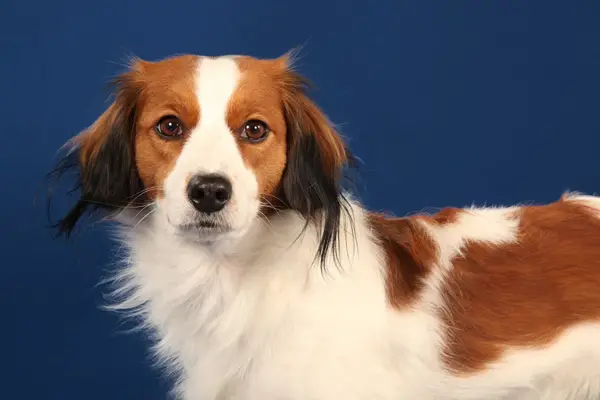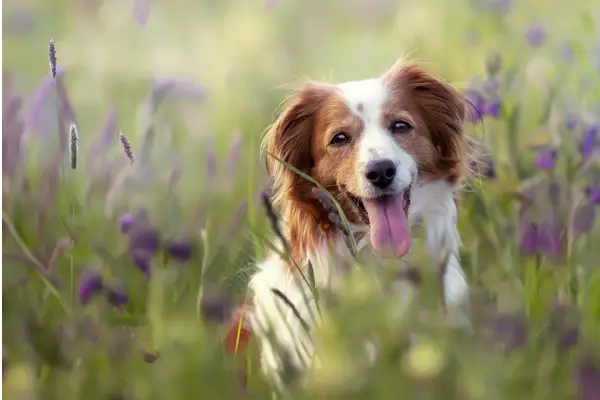The Nederlandse Kooikerhondje, or Kooikerhondje in short, are medium-sized white and orange dogs from the Netherlands. Despite their size, these dogs are big at heart, and surely, his appearance can capture anyone’s eyes.
The Nederlandse Kooikerhondje features a silky, long, beautiful, wavy coat that covers their entire bodies. Their most distinctive features are their ears that appear to have earrings and their feathery long-tail that waggles energetically when greeting.
These are active dogs, and it’s only natural that they’re paired with active and experienced owners. They can adapt well into any living conditions as long as their needs are met. But if there’s one thing you should remember, don’t get a Kooikerhondje just because you find them pretty.

Kooikerhondje Statistics
| Dog Breed Group | Sporting |
| Breed Size | Medium |
| Height | 15-17 inches (male); 14-16 inches (female) |
| Weight | 20-30 pounds |
| Lifespan | 12-13 years |
Kooikerhondje Ratings
| Energy level | |
| Exercise needs | |
| Requires attention | |
| Playfulness | |
| Trainability | |
| Shedding | |
| Grooming | |
| Friendly with family | |
| Friendly with kids | |
| Friendly with strangers | |
| Friendly with other dogs | |
| Prey Drive |
Nederlandse Kooikerhondje History
The Nederlandse Kooikerhondje is a Dutch dog from the Netherlands. They are known to be a very ancient breed that has existed since the 1500s, as evidenced by several paintings. However, it still took long before they were officially recognized.
The breed had been developed as “Decoy Dogs” for ducks. His job was to lure ducks into a trap called Kooi for the hunters to catch. These birds are then banded for research or sold to the market.
Other than this, Kooikerhondje was also used for hunting small vermins in households. Hence, they were all-around working dogs.
When World War II came, the breed almost went extinct, along with several other dog breeds. Fortunately, thanks to the Baroness von Hardenbroek van Ammerstol, the breed was preserved in late 1939.
By the year 1967, the Dutch parent club was organized, and the Dutch Kennel Club finally recognized the breed in 1971.
Now, the breed is considered relatively new, ranking 150th as the most popular in the US. The American Kennel Club only recognized them in 2018, and who knows if their rank will go higher as the years pass.

Nederlandse Kooikerhondje Temperament
Nederlandse Kooikerhondjes are generally friendly, alert, and quick dogs. Most owners say they have a wide range of personalities, from being cuddly to independent dogs.
As a highly intelligent breed, they would likely want to do things their way. This is why they must have someone experienced and firm to provide consistent leadership and keep him under control.
They are adaptable dogs and will usually adjust to your energy level to please you. You might also find them affectionate and loving, but you should remember they need to be given time and attention.
They are also usually good with children and other pets that grew up with them. They are also not aggressive with strangers, but they are cautious and do not quickly warm up.
Like any other dog breeds, early socialization is a must. This is to ensure that he becomes more well-rounded and accepting of people. This will help him get accustomed to anything new, making his temperament more stable.
Other than early socialization, the Nederlandse Kooikerhondje also needs training. If possible, all family members should get involved in the training so he’ll learn to respect each of you.
Nederlandse Kooikerhondje Care Requirements
- Nutrition: Nederlandse Kooikerhondjes can live on any diet as long as it’s of high-quality and well-balanced. One meal of a Kooiker should consist of all the essential nutrients – proteins, fats, and carbohydrates. When you’re buying ingredients for their home-cooked meals, you should only choose the high-quality ones too. Animal meat, such as beef, lamb, or poultry, is an excellent source of protein. You can get fats from fish oils, and carbohydrates from whole grains. If you plan to give them dog food or treats, choose premium quality ones. You should also check the label and make sure that it doesn’t contain any fillers, additives, and by-products that can harm your dog. Watch their weight, too, and avoid overfeeding. Overweight dogs are more prone to diseases, and you don’t want that.
- Grooming: The coat of a Nederlandse Kooikerhondje sheds seasonally. However, it does require regular grooming, so he keeps looking his best. Brushing should help remove any debris, prevent mats and tangles, and keep shedding to a minimum. Baths can be given occasionally, depending on when your dog would highly need it. However, ears should be cleaned weekly to prevent ear infection. Nails should also be trimmed regularly so as not to cause pain and discomfort to your dog.
- Exercise: Nederlandse Kooikerhondjes are lively, cheerful, and undeniably active dogs. They require a regular, low-impact exercise to keep them healthy and happy. At times, an hour of exercise should suffice, in the form of long walks or play sessions in a securely fenced yard.
- Health: Nederlandse Kooikerhondjes are generally healthy dogs with a long lifespan. However, they are also prone to getting several diseases. Although they will not get all of these in his lifetime, it’s still important for dog owners to be aware of these. Some of the most common conditions a Kooikerhondje will get are Von Willebrand’s Disease, Kooiker Paralysis, and Polymyositis. While a few minor concerns are distichiasis, hip dysplasia, and patellar luxation. Epilepsy and kidney disease are also diagnosed in a few dogs. We highly recommend meeting at least one of your dog’s parents to be aware of any existing diseases your dog may acquire, especially if it’s hereditary. You can also have your dog take occasional tests to determine existing conditions early. Continuously monitor your dog’s behavior, and if you notice any changes, take him immediately to the vet.
- Lifespan: The life expectancy of Nederlandse Kooikerhondjes is 12-15 years.

Famous Nederlandse Kooikerhondjes
Tommy: Female Nederlandse Kooikerhondje that served as the foundation of all Kooikerhondje today
Fun Facts About Nederlandse Kooikerhondjes
- Nederlandse Kooikerhondjes originated in the Netherlands way back in the 1500s.
- These dogs were bred to be decoy dogs – luring ducks into a cage (Kooi) for the hunter to catch.
- These dogs are believed to be an ancestor of the Nova Scotia Duck Tolling Retriever.
- They have distinctive ears – many of them have black tips on the ears that are often called earrings.
- They almost became extinct in the 1940s.
- Baroness Van Hardenbroek van Ammerstol was responsible for bringing the dog breed back.
- They were recognized by the American Kennel Club in 2018.
Check Out Other Sporting Dog Breeds:
American Water Spaniel, Boykin Spaniel, Brittany, Chesapeake Bay Retriever, Clumber Spaniel, Cocker Spaniel, Curly-Coated Retriever, English Cocker Spaniel, English Setter, English Springer Spaniel, Field Spaniel, Flat-Coated Retriever, German Shorthaired Pointer, German Wirehaired Pointer, Golden Retriever, Gordon Setter, Irish Red and White Setter, Irish Setter, Irish Water Spaniel, Labrador Retriever, Lagotti Romagnoli, Nova Scotia Duck Tolling Retriever, Pointer, Spinoni Italiani, Sussex Spaniel, Vizsla, Weimaraner, Welsh Springer Spaniel, Wirehaired Pointing Griffon, Wirehaired Vizslas
